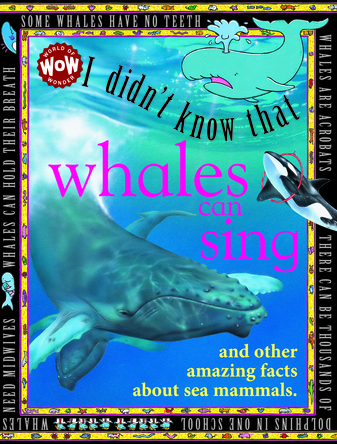Extrait du livre I didn't know that Whales can sing
Introduction Did you know that whales are mammals that breathe air? That some whales are heavier than the largest dinosaurs? That dolphins help each other when they are sick? Discover for yourself amazing facts about whales and dolphins–what they eat, how loud the humpback whale’s call can be, how they have babies, who their worst enemies are, and more. Watch for this symbol, which means there is a fun project for you to try. True or false? Watch for this symbol and try to answer the question before reading on for the answer. ! Don’t forget to check the borders for extra amazing facts!
! Whales’ fossilized remains, estimated to be 50 million years old, have been found. I didn't know that : Whales are mammals. Just like you, me, cows, horses, cats, dogs, and all the other mammals, a whale is warm-blooded, breathes air, and drinks milk from its mother when it’s a baby. Fur is of no use to sea creatures. A thick layer of fat, called “blubber,” keeps whales warm in the cold seas. Can you find the fishy impostor? A whale’s body has adapted to sea-going life. Its front legs have become flippers and its back legs have disappeared altogether–though you can see the vestiges (remains) of them on its skeleton. ! Inuits eat whale blubber to protect them from the cold.
! Blue whales are found in both freezing and tropical waters. I didn't know that : A whale is the largest animal ever to live on Earth. The blue whale is four times the size of the largest dinosaur and 25 times the size of an elephant. An animal this big couldn’t live on land–but in the sea, the water can support its enormous weight. True or false? The heart of a blue whale is four times the size of a man. Answer: True The heart weighs almost 1,000 pounds (450 kg). An average man weighs about 220 pounds (100 kg). The blue whale is sometimes known as a “sulfur-bottomed whale.” On deep dives, it picks up tiny algae that stick to it, making it glow in the dark. ! The tongue of a blue whale is the same weight as a hippopotamus!
! Sperm whales were killed for their spermaceti, which made good candle wax. I didn't know that : Whales can hold their breath. They have to! Although they are mammals that have lungs and breathe air, whales spend a lot of time under water. They come to the surface to breathe. The blowhole on top of a whale’s head is its nostril. The whale blows out air in a 33-foot-(10-meter-)high spout before taking deep breaths and going under again. True or false? You can tell a whale by its spout. Answer: True A whale’s spout is a cloud of vapor, produced when the whale’s warm breath hits the cooler air. The pictures above show spouts from different whales. Nineteenth-century whalehunters would spot the spouts from a distance and were often able to tell from them what sort of whales were nearby. Sperm whales hold the whale record for diving, with dives of almost two miles (more than three kilometers), sometimes lasting nearly two hours. Their heads contain a waxy substance called “spermaceti,” which might be what helps them survive the pressure at such great depths. ! A whale’s lungs would be crushed by its weight on land.



























